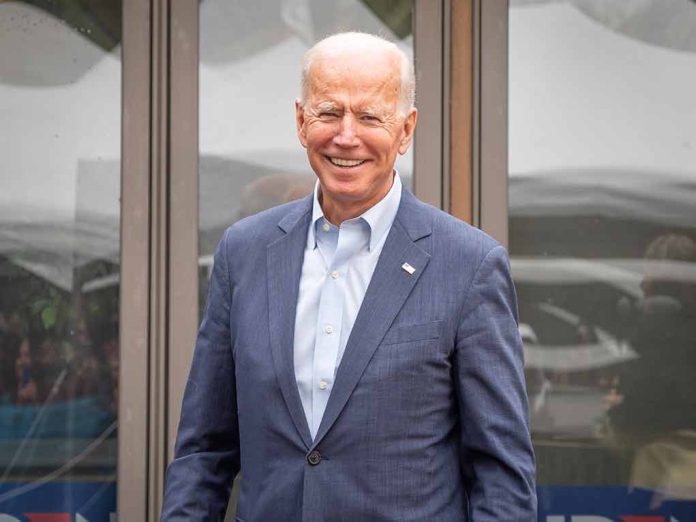
The Supreme Court’s decision not to intervene in the EPA’s power plant emissions rule marks a temporary victory for the Biden administration’s climate agenda.
At a Glance
- Supreme Court allows EPA to proceed with plans to limit carbon emissions from power plants.
- The rule aims to eliminate pollution from coal, a major source of carbon dioxide.
- Over two dozen states challenged the regulation, questioning its effectiveness.
- The ruling is provisional as the challenge progresses through lower courts.
- The rule mandates coal-fired power plants to capture 90% of carbon emissions or shut down within eight years.
Supreme Court Declines to Block EPA Emissions Rule
In a significant development for the Biden administration’s climate strategy, the U.S. Supreme Court has decided not to intervene in the Environmental Protection Agency’s (EPA) plans to limit carbon emissions from power plants. This decision allows the EPA to move forward with its regulations aimed at reducing pollution from coal-fired power plants, a major source of carbon dioxide emissions.
The ruling came in response to an emergency application filed by over two dozen states challenging the regulation. These states questioned the effectiveness of the emission control techniques proposed by the EPA. However, the conservative-majority court declined to block the rule, marking a temporary victory for the Biden administration’s environmental agenda.
🚨 BREAKING: SCOTUS just cleared the way for @POTUS' carbon pollution standards on power plants to go into effect.
The rules are one of the Biden-administration's most consequential climate actions.
This is HUGE!https://t.co/sx3kOOTlbT
— Evergreen Action (@EvergreenAction) October 16, 2024
Details of the EPA Rule and Its Implications
The EPA rule at the center of this legal battle mandates that coal-fired power plants must capture 90% of their carbon emissions or shut down within eight years. Compliance deadlines for this regulation are set to begin in 2025, with full implementation required by 2030 or 2032, depending on the specific plant.
This regulation is a crucial component of President Biden’s broader climate goals, which include eliminating carbon pollution from the electricity sector by 2035 and achieving economy-wide carbon neutrality by 2050. The EPA estimates that this rule could provide up to $370 billion in climate and health benefits and prevent 1.4 billion metric tons of carbon pollution by 2047.
Opposition and Ongoing Legal Challenges
Despite the Supreme Court’s decision, the rule faces continued opposition from various quarters. Republican-led states and industry groups, including the National Mining Association, argue that the EPA has overstepped its authority and imposed unattainable standards. They contend that the required “90% carbon capture” technology is not commercially viable and that implementing the rule could lead to plant closures and increased electricity rates.
The legal battle is far from over. The Supreme Court’s order allows the rule to remain in effect while the D.C. Circuit Court continues to review the case. Justices Brett Kavanaugh and Neil Gorsuch, while not blocking the rule, suggested that challengers might succeed on some claims in the future. This leaves the door open for further legal challenges as the case progresses through the lower courts.
Implications for Future Environmental Regulations
This decision comes at a crucial time for environmental regulation in the United States. A recent Supreme Court ruling overturning the Chevron decision may complicate future environmental regulations by potentially limiting federal agencies’ interpretive authority. Additionally, the court is considering a separate case involving EPA clean water standards enforcement, which could have significant financial implications for cities like San Francisco.
As the Biden administration continues to push forward with its climate agenda, the outcome of this ongoing legal battle will likely have far-reaching consequences for the future of environmental regulation and the nation’s efforts to combat climate change. The Supreme Court’s role in shaping climate policy remains critical, especially during this period of intense debate over the balance between economic interests and environmental protection.
Sources:
- Supreme Court clears way for Biden’s plan to cut power plant emissions
- Supreme Court Allows E.P.A. to Limit Power Plant Emissions
- Supreme Court allows rule limiting pollution from coal-fired power plants to remain in effect
- Supreme Court allows EPA emissions rule to stand while litigation continues
- US Supreme Court won’t pause EPA power plant emissions rule
- Supreme Court allows Biden to implement plan to curb carbon emissions from power plants
- Supreme Court Refuses to Freeze Greenhouse-Gas Rule
- Supreme Court allows Biden EPA to enforce climate rules for power plants










